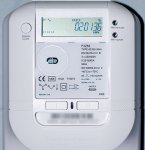All manner of such clever non invasive "winking LED" meter readings have been done in recent years.
Google! Aside from PICAXE LDR & "count" etc, approaches using
cheap USB video cameras feeding PCs running suitable motion detecting software may appeal. Some can even read analog. dials.It's quite legal, & unlike "Current Cost" plug in/clamp style apparent power (VA) sensors, the true power consumption (Watts) indeed will be shown.
Keep in mind however that diverse TOD (Time Of Day) billing rates & service charges may greatly influence the eventual $$$ charge. No doubt my NZ domestic rate is typical -3 different pricing periods, plus a FIXED daily "service charge" & then eventual GST taxes levied. That's right - a tax on a tax, but a prompt payment discount may apply. Estimated readings also arise when the likes of our dog keeps the meter reader away - "GOOD BOY"! The bill gets so confusing that raw PIC programming looks a breeze in comparison.
During closed up home periods, holidays or over the summer etc, these tedious $$($) extra charges may be higher (sometimes by an order of magnitude) than the actual $($) energy cost!
But back on topic -stray light is often a hassle for indirect LED reading. Here in NZ my home's NILSEN EMS 2100 smart outdoor utility meter (c/w compulsory cabinet reading window) is bathed in direct sunlight at times, & this fools even a significantly masked sensor.
In my experiences boring aspects like the project power supply & wires trailing to your PC eventually tend to limit the appeal of such a project. SWMBO ("She Who Must Be Obeyed") can find these an eyesore & threaten to turn off your beer fridge etc in protest. Although scope for wireless links (433 MHz/ZigBee?) may arise (& utility companies increasingly fit these for drive by/walk by billing anyway), a grunty battery pack will be needed to handle "always on" DIY readings. Heavy loads mean rapidly flashing LED rates, so even simple PICAXE sleeps are not feasible.
FWIW: I've a mate cursed with a poorly sited high/dark/cobweb covered switchboard,who just mounted a small cheap USB PC camera (& illuminating LED) for more convenient views of the dials from his PC. Such a PC cam approach has appeal for snail mail postboxes -
or even rooftop views over the neighbourhood etc! Stan.

